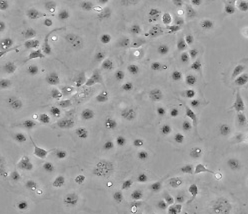SV40转化的非洲绿猴肾细胞COS-7
BLUEFBIO™ Product Sheet
|
细胞名称 |
SV40转化的非洲绿猴肾细胞COS-7 |
|
|
|
货物编码 |
BFN608006384 |
||
|
产品规格 |
T25培养瓶x1 |
1.5ml冻存管x2 |
|
|
细胞数量 |
1x10^6 |
1x10^6 |
|
|
保存温度 |
37℃ |
-198℃ |
|
|
运输方式 |
常温保温运输 |
干冰运输 |
|
|
安全等级 |
1 |
||
|
用途限制 |
仅供科研用途 1类 |
||
|
培养体系 |
DMEM高糖培养基(Hyclone)+10%胎牛血清(Gibco)+1%双抗(Hyclone) |
||
|
培养温度 |
37℃ |
二氧化碳浓度 |
5% |
|
简介 |
SV40转化的非洲绿猴肾细胞COS-7细胞株源自CV-1细胞株,经转染起始点缺失的SV40病毒突变体得到;编码表达野生型T抗原,所以该细胞适合作为需要SV40T抗原表达的载体的转染宿主。该细胞表达T抗原,允许SV40病毒的溶解性生长,支持40℃时温度敏感性A209病毒的复制,支持起始区域缺陷的SV40突变体的复制。因含有SV40病毒的DNA序列,该细胞需要在2级生物安全柜中操作。 SV40转化的非洲绿猴肾细胞COS-7细胞由青旗(上海)生物技术发展有限公司于2019年引种自ATCC(CRL-1651) |
||
|
注释 |
Group: Non-human primate cell line. Doubling time: ~35-48 hours (DSMZ), ~2 days (lot 03052018), ~30 hours (lots 10052007 and 11222004), ~34 hours (lot 02292000) (JCRB). Transformant: NCBI_TaxID; 1891767; Simian virus 40 (SV40) [pSV6-1]. Misspelling: COS-2; In PubMed=14662750, PubMed=17074883 and PubMed=19379694, personal communication of Galan J. |
||
|
STR信息 |
/ |
||
|
参考文献 |
Gluzman Y. SV40-transformed simian cells support the replication of early SV40 mutants. Cell 23: 175-182, 1981. PubMed: 6260373
Fernandez LM, Puett D. Lys583 in the third extracellular loop of the lutropinoriogonadotropin receptor is critical for signaling. J. Biol. Chem. 271: 925-930, 1996. PubMed: 8557706
Maestrini E, et al. A family of transmembrane proteins with homology to the MET-hepatocyte growth factor receptor. Proc. Natl. Acad. Sci. USA 93: 674-678, 1996. PubMed: 8570614
Campbell M, et al. The simian foamy virus type 1 transcriptional transactivator (Tas) binds and activates an enhancer element in the gag gene. J. Virol. 70: 6847-6855, 1996. PubMed: 8794326
Gonzalez Armas JC, et al. DNA immunization confers protection against murine cytomegalovirus infection. J. Virol. 70: 7921-7928, 1996. PubMed: 8892915
Jang SI, et al. Activator protein 1 activity is involved in the regulation of the cell type-specific expression from the proximal promoter of the human profilaggrin gene. J. Biol. Chem. 271: 24105-24114, 1996. PubMed: 8798649
Dittrich E, et al. A di-leucine motif and an upstream serine in the interleukin-6 (IL-6) signal transducer gp130 mediate ligand-induced endocytosis and down-regulation of the IL-6 receptor. J. Biol. Chem. 271: 5487-5494, 1996. PubMed: 8621406
Lee JH, et al. The proximal promoter of the human transglutaminase 3 gene. J. Biol. Chem. 271: 4561-4568, 1996. PubMed: 8626812
Chen Y, et al. Demonstration of binding of dengue virus envelope protein to target cells. J. Virol. 70: 8765-8772, 1996. PubMed: 8971005
Russell DW, Miller AD. Foamy virus vectors. J. Virol. 70: 217-222, 1996. PubMed: 8523528
Wright DA, et al. Association of human fas (CD95) with a ubiquitin-conjugating enzyme (UBC-FAP). J. Biol. Chem. 49: 31037-31043, 1996. PubMed: 8940097
Zhang J, et al. Dynamin and beta-arrestin reveal distinct mechanisms for G protein-coupled receptor internalization. J. Biol. Chem. 271: 18302-18305, 1996. PubMed: 8702465
Ozcelebi F, et al. Phosphorylation of cholecystokinin receptors expressed on chinese hamster ovary cells. J. Biol. Chem. 271: 3750-3755, 1996. PubMed: 8631990
Gibson S, et al. Functional LCK is required for optimal CD28-mediated activation of the TEC family tyrosine kinase EMT/ITK. J. Biol. Chem. 271: 7079-7083, 1996. PubMed: 8636141
Shaul PW, et al. Acylation targets endothelial nitric-oxide synthase to plasmalemmal caveolae. J. Biol. Chem. 271: 6518-6522, 1996. PubMed: 8626455
Ladner RD, et al. Identification of a consensus cyclin-dependent kinase phosphorylation site unique to the nuclear form of human deoxyuridine triphosphate nucleotidohydrolase. J. Biol. Chem. 271: 7752-7757, 1996. PubMed: 8631817
Wu X, et al. Demonstration of a physical interaction between microsomal triglyceride transfer protein and apolipoprotein B during the assembly of ApoB-containing lipoproteins. J. Biol. Chem. 271: 10277-10281, 1996. PubMed: 8626595
Hawes BE, et al. Phosphatidylinositol 3-kinase is an early intermediate in the G beta gamma-mediated mitogen-activated protein kinase signaling pathway. J. Biol. Chem. 271: 12133-12136, 1996. PubMed: 8647803
Arai H, Charo IF. Differential regulation of G-protein-mediated signaling by chemokine receptors. J. Biol. Chem. 271: 21814-21819, 1996. PubMed: 8702980
Hsieh CM, et al. APEG-1, a novel gene preferentially expressed in aortic smooth muscle cells, is down-regulated by vascular injury. J. Biol. Chem. 271: 17354-17359, 1996. PubMed: 8663449
Holtmann MH, et al. Multiple extracellular loop domains contribute critical determinants for agonist binding and activation of the secretin receptor. J. Biol. Chem. 271: 14944-14949, 1996. PubMed: 8663161 |
||
验收细胞注意事项
1、收到SV40转化的非洲绿猴肾细胞COS-7细胞,请查看瓶子是否有破裂,培养基是否漏出,是否浑浊,如有请尽快联系。
2、收到SV40转化的非洲绿猴肾细胞COS-7细胞,如包装完好,请在显微镜下观察细胞。,由于运输过程中的问题,细胞培养瓶中的贴壁细胞有可能从瓶壁中脱落下来,显微镜下观察会出现细胞悬浮的情况,出现此状态时,请不要打开细胞培养瓶,应立即将培养瓶置于细胞培养箱里静止 3-5 小时左右,让细胞先稳定下,再于显微镜下观察,此时多数细胞会重新贴附于瓶壁。如细胞仍不能贴壁,请用台盼蓝染色法鉴定细胞活力,如台盼蓝染色证实细胞活力正常请按悬浮细胞的方法处理。
3、收到SV40转化的非洲绿猴肾细胞COS-7细胞后,请镜下观察细胞,用恰当方式处理细胞。若悬浮的细胞较多,请离心收集细胞,接种到一个新的培养瓶中。弃掉原液,使用新鲜配制的培养基,使用进口胎牛血清。刚接到细胞,若细胞不多时 血清浓度可以加到 15%去培养。若细胞迏到 80%左右 ,血清浓度还是在 10%。
4、收到SV40转化的非洲绿猴肾细胞COS-7细胞时如无异常情况 ,请在显微镜下观察细胞密度,如为贴壁细胞,未超过80%汇合度时,将培养瓶中培养基吸出,留下 5-10ML 培养基继续培养:超过 80%汇合度时,请按细胞培养条件传代培养。如为悬浮细胞,吸出培养液,1000 转/分钟离心 3 分钟,吸出上清,管底细胞用新鲜培养基悬浮细胞后移回培养瓶。
5、将培养瓶置于 37℃培养箱中培养,盖子微微拧松。吸出的培养基可以保存在灭菌过的瓶子里,存放于 4℃冰箱,以备不时之需。
6、24 小时后,SV40转化的非洲绿猴肾细胞COS-7细胞形态已恢复并贴满瓶壁,即可传代。(贴壁细胞)将培养瓶里的培养基倒去,加 3-5ml(以能覆盖细胞生长面为准)PBS 或 Hanks’液洗涤后弃去。加 0.5-1ml 0.25%含 EDTA 的胰酶消化,消化时间以具体细胞为准,一般 1-3 分钟,不超过 5 分钟。可以放入37℃培养箱消化。轻轻晃动瓶壁,见细胞脱落下来,加入 3-5ml 培养基终止消化。用移液管轻轻吹打瓶壁上的细胞,使之完全脱落,然后将溶液吸入离心管内离心,1000rpm/5min。弃上清,视细胞数量决定分瓶数,一般一传二,如细胞量多可一传三,有些细胞不易传得过稀,有些生长较快的细胞则可以多传几瓶,以具体细胞和经验为准。(悬浮细胞)用移液管轻轻吹打瓶壁,直接将溶液吸入离心管离心即可。
7、贴壁细胞 ,悬浮细胞。严格无菌操作。换液时,换新的细胞培养瓶和换新鲜的培养液,37℃,5%CO2 培养。
特别提醒: 原瓶中培养基不宜继续使用,请更换新鲜培养基培养。


